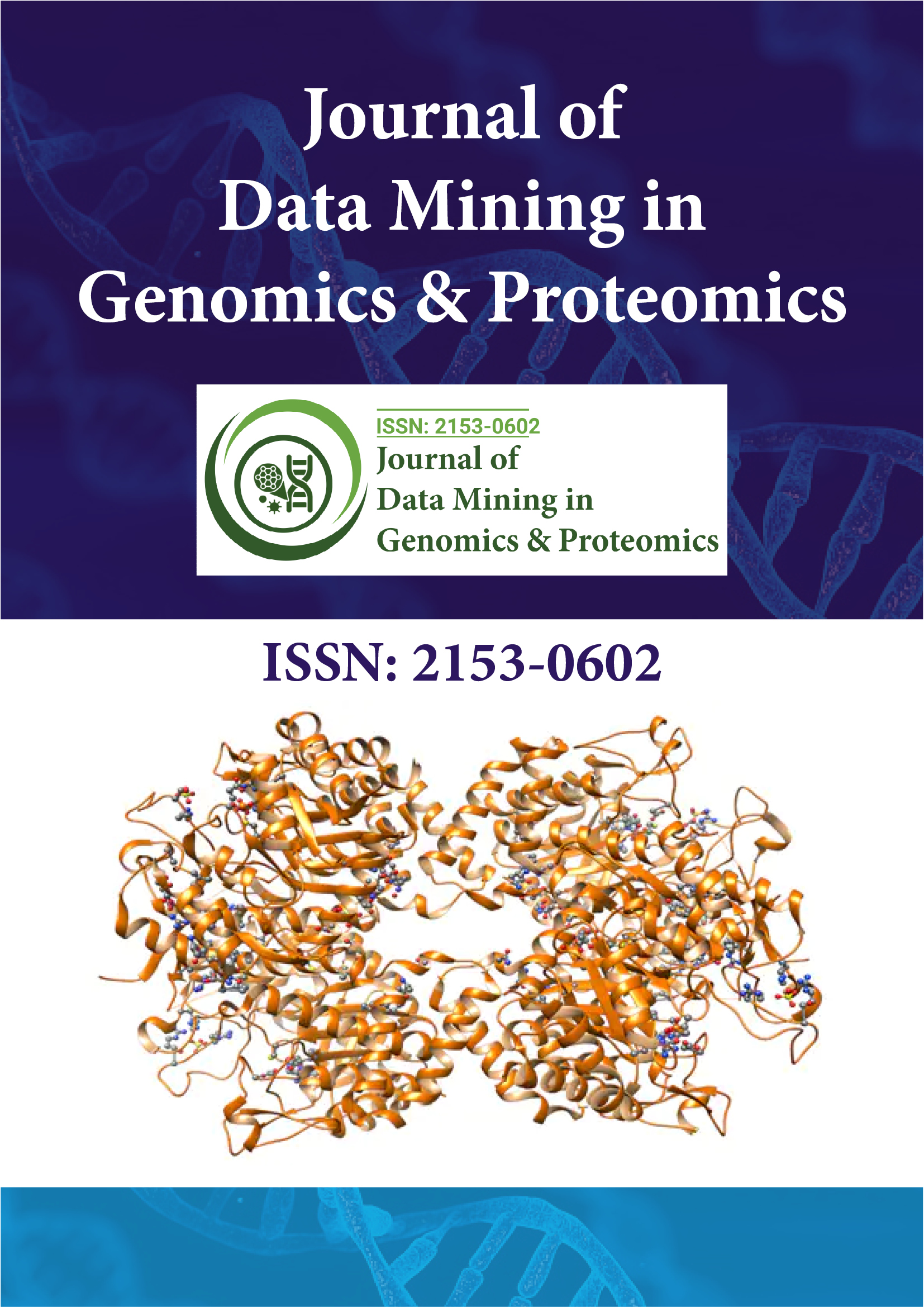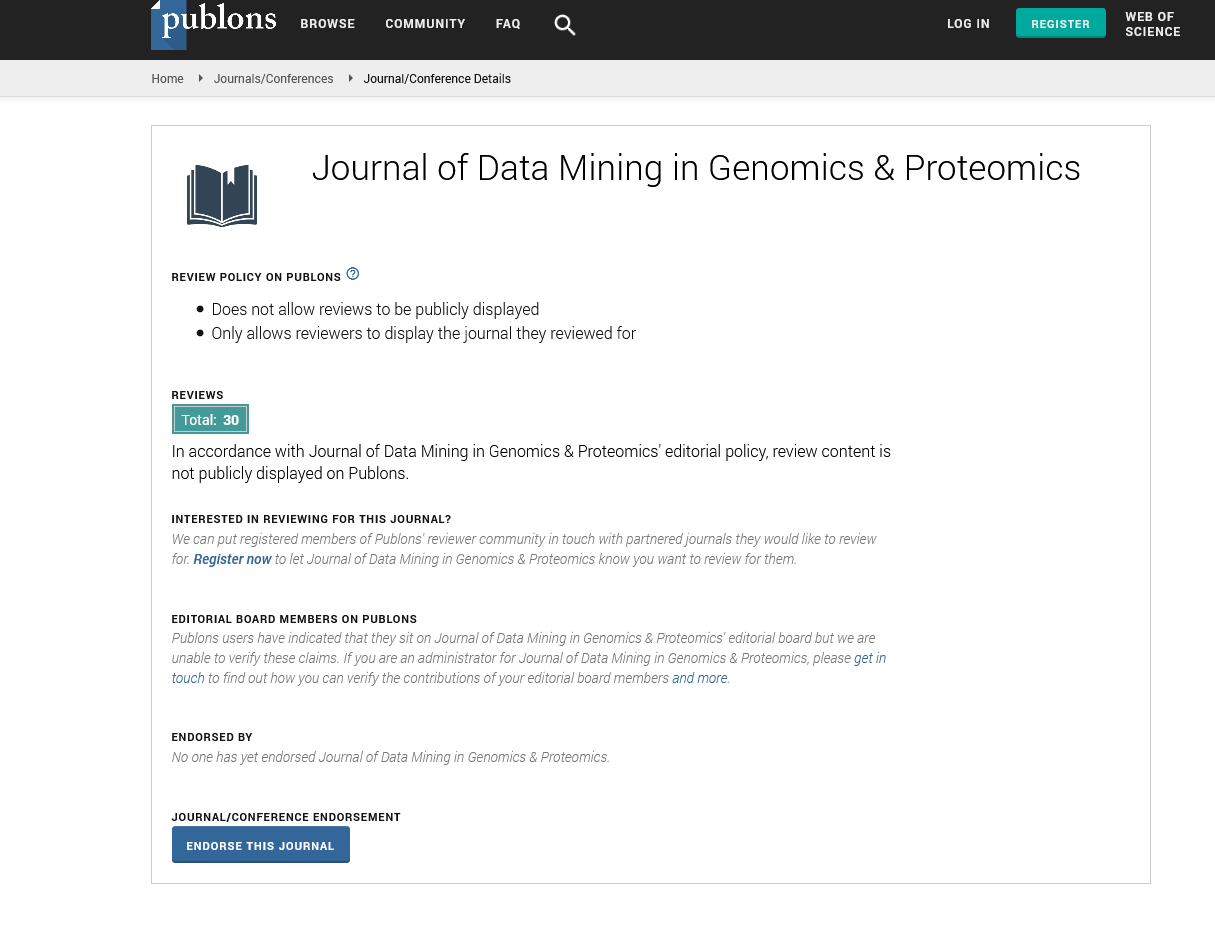PMC/PubMed Indexed Articles
Indexed In
- Academic Journals Database
- Open J Gate
- Genamics JournalSeek
- JournalTOCs
- ResearchBible
- Ulrich's Periodicals Directory
- Electronic Journals Library
- RefSeek
- Hamdard University
- EBSCO A-Z
- OCLC- WorldCat
- Scholarsteer
- SWB online catalog
- Virtual Library of Biology (vifabio)
- Publons
- MIAR
- Geneva Foundation for Medical Education and Research
- Euro Pub
- Google Scholar
Useful Links
Share This Page
Journal Flyer

Open Access Journals
- Agri and Aquaculture
- Biochemistry
- Bioinformatics & Systems Biology
- Business & Management
- Chemistry
- Clinical Sciences
- Engineering
- Food & Nutrition
- General Science
- Genetics & Molecular Biology
- Immunology & Microbiology
- Medical Sciences
- Neuroscience & Psychology
- Nursing & Health Care
- Pharmaceutical Sciences
Commentary - (2022) Volume 13, Issue 6
Advanced in the Applications of Proteomic Technologies in Molecular Sciences
Torsten Remirez*Received: 04-Nov-2022, Manuscript No. JDMGP-22-18810; Editor assigned: 07-Nov-2022, Pre QC No. JDMGP-22-18810 (PQ); Reviewed: 21-Nov-2022, QC No. JDMGP-22-18810; Revised: 28-Nov-2022, Manuscript No. JDMGP-22-18810 (R); Published: 05-Dec-2022, DOI: 10.4172/2153-0602.22.13.267
Description
The study of proteins' identities, levels of expression, and modifications has become a crucial area of study in the molecular sciences. For instance, cancer proteomics revealed important data in mechanistic studies on tumors development and metastasis, which helped to identify treatment targets as well as therapeutically useful indicators. Worldwide sharing of many cancer proteome datasets has been created. The integration of proteomics research with other comics is crucial since it is generating a wealth of information on molecular pathways and target modulators. Bioinformatics pipelines can be used to analyses and process this data in order to provide relevant information.
The progress of proteomics has led to the discovery of hundreds of biomarkers. The investigated biomarkers have significantly improved the accuracy of diagnosis in some particular diseases and decreased some unneeded invasive biopsies since protein markers may represent body state better than other types of biomarkers like DNA. Plasma, saliva, lavage fluid, and effusion are the best bodily fluids to use as samples for clinical proteomics. Proteomics can also be used with other methods to improve patient care and stratification based on more logical categorization and early discovery. The improvement of improving sensitivity and specificity is still needed. Surgery, chemotherapy, and conventional radiation are the mainstays of lung cancer treatment. In the meanwhile, innovative treatments like immunotherapy have also been created [1].
Analytical platforms for proteomics
In order to identify every protein in an organism and to discover qualitative and quantitative protein variations upon various environmental changes, analytical systems for proteomics have been created. Building an amino acid sequence database on the makeup of proteins has also made extensive study on proteins possible. The following procedures are often included in a proteomic analysis: Protein extraction, protease digestion, peptide fractionation, and LC-MS analysis are the first four steps. Initially, centrifugation and filtration are used to separate and purify proteins from tissue or cell lysates. In order to simplify the sample, the protein mixture is often separated using two-dimensional gel electrophoresis [2].
Application of proteomics in cancers
Cancer is characterized by abnormal cell proliferation, in which the normal cell's cell cycle is disturbed by a number of genetic changes. Cancer may develop in any bodily tissue and is distinguished by its propensity to infiltrate or spread to other organs and tissues. A crucial scientific method for examining the biochemical alterations in cancer is proteomics. Key details, including protein targets and signaling pathways associated to the development and spread of cancer cells, have been discovered using proteomics techniques [3].
Proteomics approach in brain cancer
Glioblastoma Multiforme (GBM) is a very aggressive primary brain tumors that manifests as a variety of malignant kinds, has a bad prognosis, a high degree of tumors invasiveness, and progresses quickly, leaving patients disabled while undergoing treatment. Therefore, it is crucial to find biomarkers as soon as possible in order to monitor therapeutic response in GBM patients correctly. Proteomics investigations have effectively discovered variations in protein expression patterns in GBM in this aspect [4].
Proteomics approach in lung cancer
Although lung cancer mortality has declined dramatically over the past ten years, it is still one of the top causes of death and has a considerable negative impact on people's quality of life and health. A multi-omics research paradigm may be created by combining the developing field of proteomics with genomes and transcriptomics. Proteomics involves the application of methods for detecting and measuring the total amount of proteins in cells, tissues, and organisms. Proteomics may be used to several clinical aspects including diagnosis, therapy, and prognosis by comparing the protein content of normal and malignant tissues, particularly the investigation of disease biomarkers and therapeutic targets. The use of proteomics has advanced studies into lung cancer.
An organization called the International Cancer Genome Consortium (ICGC) has systematically examined over 25,000 cancer genomes at the multi-omics level for 50 different cancer types. It also provides a forum for the collaboration of cancer genome researchers in the fields of genomics and informatics. These extensive research projects have gathered information on whole genome and exome somatic mutations from patients with various cancers, including breast, colorectal, pancreatic, and GBM, as well as a variety of oncogenic mutations that allow the definition of clinically significant types for prognosis and posttreatment management. Recent attention has been drawn to the use of Artificial Intelligence (AI) or Machine Learning (ML) to combine a sizable quantity of caner proteome and manage data complexity from several data sources. Algorithms may be developed using AI to perform better when particular sorts of resources or data are made available. Several researches have employed Artificial Intelligence (AI) methods to find new cancer biomarkers or forecast cancer stages [5].
REFERENCES
- Lu CL, Qv XY, Jiang JG. Proteomics and syndrome of Chinese medicine. J Cell Mol Med. 2010;14(12):2721-2728.
- Lao Y, Wang X, Xu N, Zhang H, Xu H. Application of proteomics to determine the mechanism of action of traditional Chinese medicine remedies. J Ethnopharmacol. 2014;155(1):1-8.
- Cristea IM, Gaskell SJ, Whetton AD. Proteomics techniques and their application to hematology. Blood. 2004;103(10):3624-334.
- Pandey A, Mann M. Proteomics to study genes and genomes. Nature. 2000;405(6788):837-846.
- Liu Y, Liu P, Dai R, Wang J, Zheng Y, Shen J, et al. Analysis of plasma proteome from cases of the different traditional Chinese medicine syndromes in patients with chronic hepatitis B. J Pharm Biomed Anal. 2012;59:173-178.
Citation: Remirez T (2022) Advanced in the Applications of Proteomic Technologies in Molecular Sciences. J Data Mining Genomics Proteomics. 13:267.
Copyright: © 2022 Remirez T. This is an open access article distributed under the terms of the Creative Commons Attribution License, which permits unrestricted use, distribution, and reproduction in any medium, provided the original author and source are credited.

